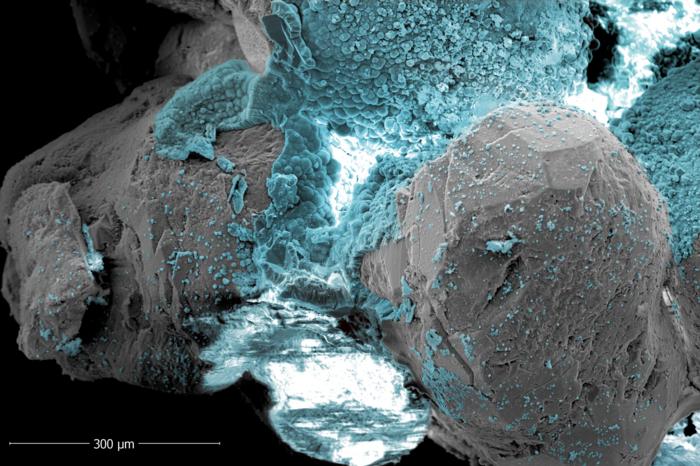Coastlines are eroding under pressure from rising oceans and more powerful storms, but help could come in a surprisingly modest form; a gentle electric voltage applied to wet sand.
Sea level rise is among the greatest threats posed by human-induced global heating. However, the imagined problem of cities and farmlands permanently sunk beneath the waves won’t be a threat in most places for a long time. Much more urgent is the way rare extreme high tides induce erosion, causing the shoreline to retreat and exposing homes and vital infrastructure.
Traditional methods to prevent this, such as tidal barriers, are expensive and can have negative side effects, but natural barriers such as coral reefs often do much better. Dr Alessandro Rotta Loria of Northwestern University looked at the way bivalves such as clams and mussels resist the waves for inspiration. They dissolve minerals from seawater to build their shells, leading Rotta Loria and colleagues to seek a way to do something similar, cementing sand grains together to build something stronger.
Mollusks rely on energy they release from their food for this purpose, but Rotta Loria showed electrical current can do the same thing. Lightning bolts have been turning sand to rock since the Earth began, but that much energy is not really practical to produce on a widespread basis. Fortunately, the researchers found it is also unnecessary.
Modest electrical stimulus releases dissolved minerals from seawater to bind sand together into a rock-like solid. That may not be what you want on your favorite surfing beach, but it’s good news for communities under threat, like the house swept away last week by waves from a hurricane hundreds of kilometers away.
It only takes 2-3 volts to trigger the desired chemical reactions in seawater, producing calcium carbonate – the primary ingredient of not only hard corals but seashells and limestone. Increasing the voltage slightly further produces magnesium hydroxide and, surprisingly to the researchers, hydromagnesite, Mg5(CO3)4(OH)2.4H2O, a component of stalactites and stalagmites.

It doesn’t take large-scale instruments to produce cement from seawater and electricity.
Image Credit: Northwestern University
In the presence of sand, these molecules act like mortar between bricks. The researchers found the approach works for the iron sands common around volcanoes, as well as the more widespread silica beaches.
“After being treated, the sand looks like a rock,” Rotta Loria said in a statement. “It is still and solid, instead of granular and incohesive. The minerals themselves are much stronger than concrete, so the resulting sand could become as strong and solid as a sea wall.” Nor is this necessarily a case of sacrificing beaches we like to lie or walk on to become rock ledges; often what is needed is to stabilize foundations, without changing what is above.
The process starts instantaneously, but for a long-term fix, the team found voltage needs to be applied for several days.
The process can even be reversed if the threat passes and people decide they’d like their sand back. “The minerals form because we are locally raising the pH of the seawater around cathodic interfaces,” Rotta Loria said. “If you switch the anode with the cathode, then localized reductions in pH are involved, which dissolve the previously precipitated minerals.”

Sand grains and electrodeposited natural cement under a powerful microscope.
Image Credit: Northwestern University
“Over 40 percent of the world’s population lives in coastal areas,” Rotta Loria said. “Because of climate change and sea-level rise, erosion is an enormous threat to these communities. Through the disintegration of infrastructure and loss of land, erosion causes billions of dollars in damage per year worldwide. Current approaches to mitigate erosion involve building protection structures or injecting external binders into the subsurface.”
“My aim was to develop an approach … [that] could cement marine substrates without using actual cement,” Rotta Loria added.
The scale of the problem is widely overlooked, but previous studies have indicated 26 percent of Earth’s beaches will be washed away by 2100 without intervention.
A lot of proposals for climate “fixes” are technological marvels, but unaffordable at the scale required. As yet, this work has yet to be demonstrated outside the laboratory. However, the team think it will cost $3-$6 per cubic meter (10-20c per cubic foot) of electrically stimulated rock produced. Existing methods are as much as 20 times that.
The process, known as electrodeposition, is already used to fight the corrosion of metal structures in the ocean, but much bigger opportunities may have been overlooked. Even if there isn’t the market to protect entire shorelines this way, the lab has found that the approach can fix cracking in existing concrete marine infrastructure, helping it last much longer.
The study is open access in Communications Earth & Environment.
Source Link: Zap Of Electricity Could Save Coastlines From Climate Change Driven Erosion